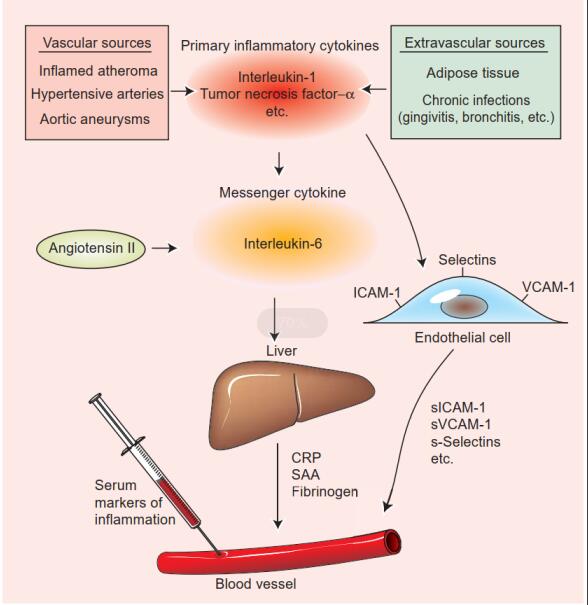What is inflammatory marker?
Inflammatory markers are widely used at clinical diagnosis of various diseases, there are several of them attracted attentions in the recent years: CRP, SAA, PCT, IL-6, and a new marker to be discovered, MxA.
Introduction to inflammatory marker
C-reactive protein (CRP): CRP is one of the earliest and most detected markers in clinical application. The concentration of CRP in the blood of healthy people is very low, but in emergency situations such as infection, trauma, surgery, tissue necrosis, and acute inflammation, the concentration of CRP increases sharply. In the absence of inflammation, high-sensitivity C-reactive protein (hs-CRP) is considered as a mediator and marker of atherosclerotic thrombotic disease, and can be used to monitor potential cardiovascular risks from time to time and assist in the diagnosis of cardiovascular disease.
Serum Amyloid A (SAA): SAA is one of the acute phase proteins that shows more sensitivity. When viral or bacterial infection occurs, SAA begins to increase significantly within 3-6 hours, and increases to hundreds or even thousands of times in acute state. SAA has a short half-life and can rapidly decline during the recovery period of the disease.
Procalcitonin (PCT): PCT is a specific indicator for diagnosing bacterial infection, a strong evidence for clinical diagnosis, and has high sensitivity and specificity. In severe systemic bacterial infection, serum PCT can increase in the early stage, and it returns to the normal range faster than CRP when the infection is controlled, but it generally does not increase in local infection. Therefore, it is often used for the differential diagnosis of sepsis and to assess the severity and progression of sepsis.
Interleukin 6 (IL-6): IL-6 is a multifunctional cytokine involved in the pathological process of various clinical diseases, including bacterial infection, neonatal sepsis, respiratory failure, systemic lupus erythematosus, cardiovascular disease and other acute and chronic inflammatory diseases. After the inflammatory response, IL-6 is produced first and then induces the production of CRP and PCT. During bacterial infection, IL-6 increases rapidly, PCT increases after 2h, and CRP increases rapidly after 6h, so it can be used to assist the early diagnosis of acute infection. Dynamic observation of IL-6 levels can help to understand the progression of infectious diseases and the response to treatment.
MxA new marker
Mx proteins are interferon-induced GTPases and central players of the innate immune system. They mediate cellular resistance against a wide range of viruses, including influenza viruses and many other related viruses.
MxA protein acts on the viral capsid and can inhibit viral transcription and translation. It is closely related to viral #infection, and a small amount or even a small amount of virus can induce cell expression, which can be used for early diagnosis of viral infection.

Why should we do combo test?
With the deepening of the research on inflammatory factors, it was found that the combined detection of PCT and IL-6 not only has complementary advantages, but also has a higher diagnostic value. IL-6 combined with PCT to detect sepsis infection can improve the sensitivity, specificity and accuracy of PCT single detection, and can greatly improve the diagnostic efficiency.
PCT combined with IL-6 detection makes it easier to distinguish G+ and G- bacteria. Studies have shown that the serum IL-6 level in patients with G-bacteremia was significantly higher than that in patients with G+ bacteremia, and the level of IL-6 was much higher than that in the G+ infection group. Therefore, if both PCT and IL-6 are significantly increased, the possibility of G- bacteria infection is high. If PCT is high, but IL-6 is not obvious, the possibility of G+ bacteria should be considered.
CRP and SAA are mainly used for the differential diagnosis of infectious diseases. In the case of virus infection, the change level of serum SAA is more sensitive than the change of CRP, which can be used as a sensitive and reliable detection index for judging virus infection. In particular, the combined detection of changes in serum SAA+CRP ratio is more helpful for the differential diagnosis of bacterial and viral infections, and is also a sensitive indicator for early diagnosis, curative effect and prognosis evaluation of infection. The rational use of antibiotics is also of great significance in containing and delaying the emergence of drug-resistant bacteria.
The combined detection of IL-6 and CRP can provide strong evidence for the differential diagnosis of early bacterial and viral infections. Especially in the early diagnosis of pediatric infectious diseases and neonatal sepsis, it has greater significance than single item in the early identification of bacterial and viral infections in infants and young children.
Due to the high sensitivity and specificity of MxA to viruses, the combined detection of MxA and CRP can be tested simultaneously to identify clinically underlying febrile acute respiratory infections (ARI) and aid in the identification of viral and bacterial infections.

















